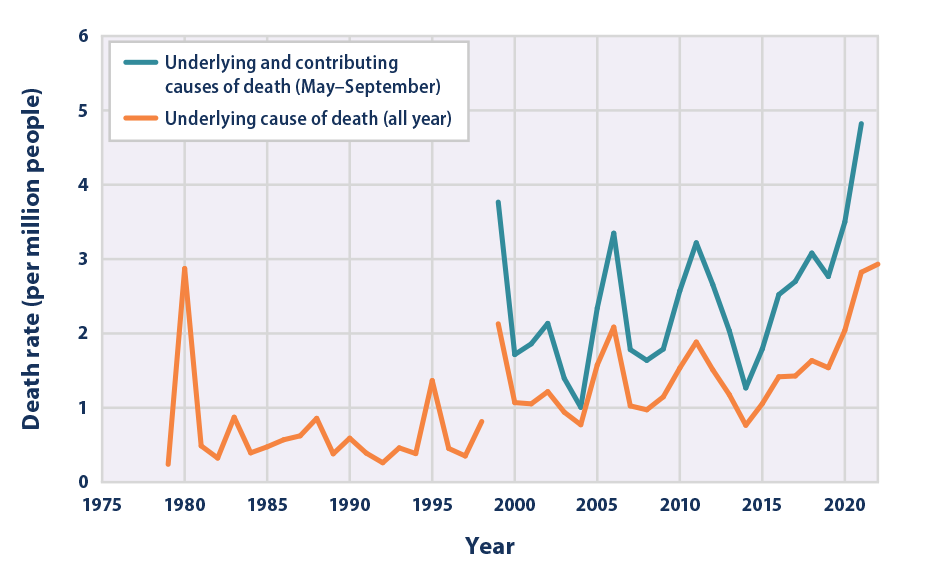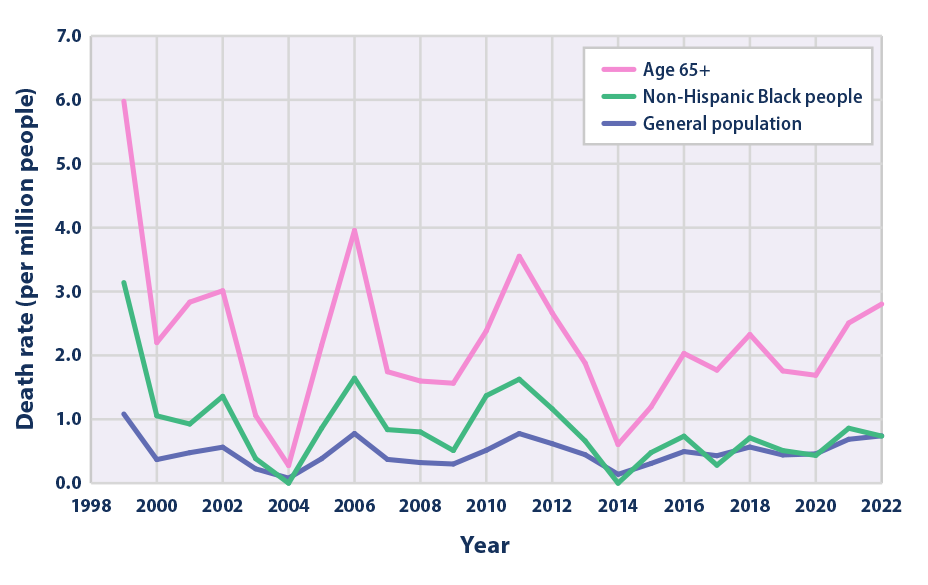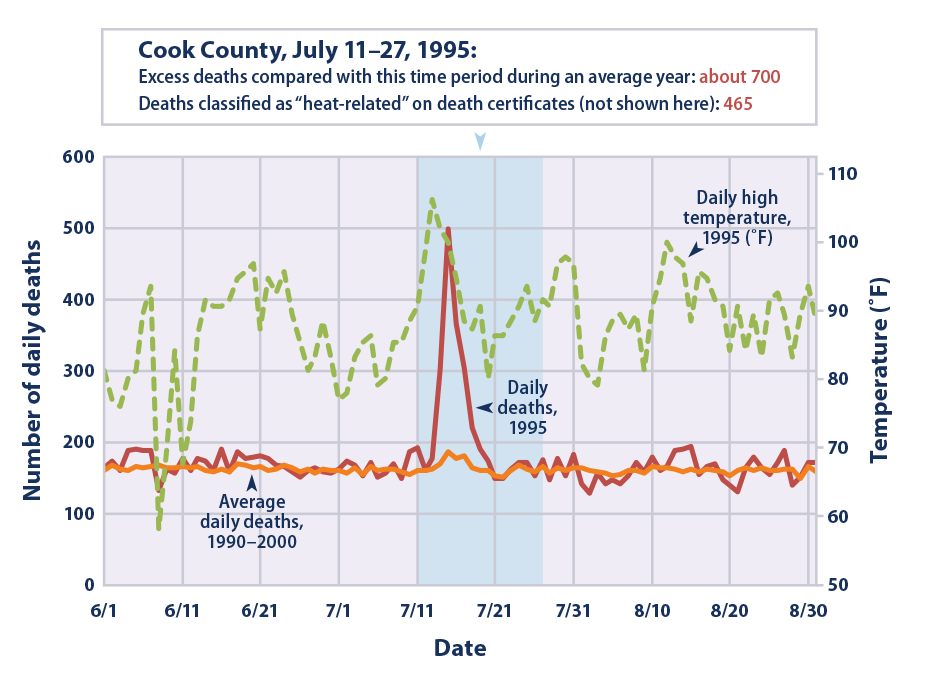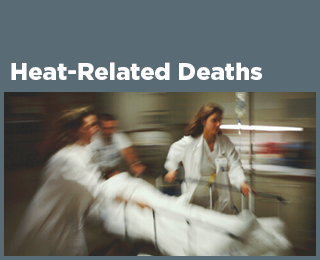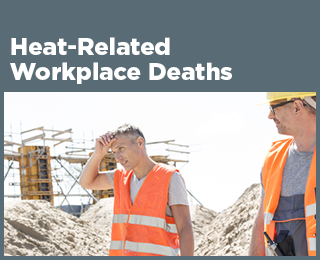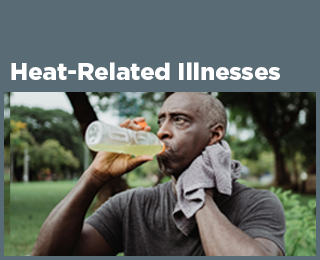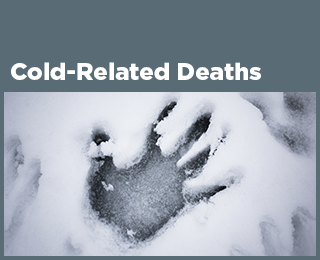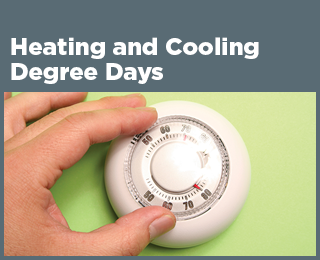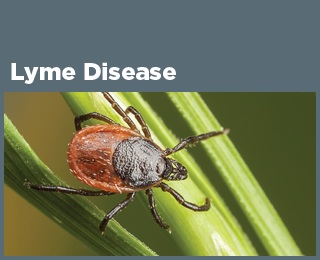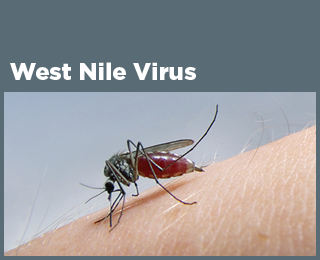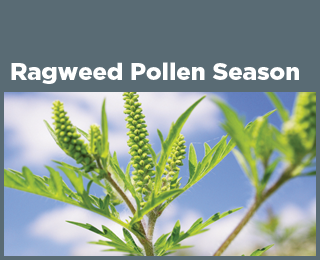Climate Change Indicators: Heat-Related Deaths
This indicator presents data on deaths classified as “heat-related” in the United States.
Key Points
- Between 1979 and 2022, the death rate as a direct result of exposure to heat (underlying cause of death) generally hovered between 0.5 and 2 deaths per million people, with spikes in certain years (see Figure 1). Overall, a total of more than 14,000 Americans have died directly from heat-related causes since 1979, according to death certificates.
- For years in which the two records overlap (1999–2021), accounting for those additional deaths in which heat was listed as a contributing factor results in a higher death rate—nearly double for some years—compared with the estimate that only includes deaths where heat was listed as the underlying cause (see Figure 1).
- The indicator shows heat-related deaths reaching new highs in 2021 and 2022, which were two of the hottest years on record in the contiguous 48 states (see the U.S. and Global Temperature indicator) and featured several notable heat waves.
- The death rate from heat-related cardiovascular disease ranged from 0.08 deaths per million people in 2004 to 1.08 deaths per million people in 1999 (see Figure 2). Overall, the interaction of heat and cardiovascular disease caused about one-fifth of the heat-related deaths recorded in the “underlying and contributing causes” analysis since 1999 (see Figures 1 and 2).
- Since 1999, people aged 65+ have been several times more likely to die from heat-related cardiovascular disease than the general population, while non-Hispanic Black people generally have had higher-than-average rates (see Figure 2).
- Examination of extreme events has revealed challenges in capturing the full extent of “heat-related” deaths. For example, studies of the 1995 heat wave event in Chicago (see example figure) suggest that there may have been hundreds more deaths than were actually reported as “heat-related” on death certificates.
- It is difficult to determine if the United States has experienced a meaningful increase or decrease in deaths classified as “heat-related” over time. While dramatic increases in heat-related deaths are closely associated with the occurrence of hot temperatures and heat waves, deaths may not be reported as “heat-related” on death certificates and there is considerable year-to-year variability in the data.
Background
When people are exposed to extreme heat, they can suffer from potentially deadly illnesses, such as heat exhaustion and heat stroke. Hot temperatures can also contribute to deaths from heart attacks, strokes, and other forms of cardiovascular disease. According to the National Weather Service, heat is a leading weather-related killer in the United States,1 even though most heat-related deaths are preventable through outreach and intervention (see EPA’s Excessive Heat Events Guidebook at: www.epa.gov/heatislands/excessive-heat-events-guidebook).
Unusually hot temperatures have become more common across parts of the United States in recent decades2 (see the High and Low Temperatures indicator), extreme heat events (heat waves) have become more frequent and intense throughout the country (see the Heat Waves indicator), and these trends are expected to continue.2 As a result, the risk of heat-related deaths and illness is also expected to increase unless people take steps to mitigate the impact or adapt.3 The “heat island” effect accentuates the problem by causing even higher temperatures in densely developed urban areas.4 Reductions in cold-related deaths are projected to be smaller than increases in heat-related deaths in most regions.5 Death rates can also change, however, as people acclimate to higher temperatures and as communities strengthen their heat response plans and take other steps to continue to adapt.
Certain population groups already face higher risks of heat-related death and increases in summertime temperature variability will increase that risk.5,6 The population of adults aged 65 and older, which is expected to continue to grow, has a higher-than-average risk of heat-related death. Children are particularly vulnerable to heat-related illness and death, as their bodies are less able to adapt to heat than adults, and they must rely on others to help keep them safe.7 People with certain diseases, such as cardiovascular and respiratory illnesses, are especially vulnerable to excessive heat exposure, as are the economically disadvantaged. Data also suggest a higher risk among non-Hispanic Black people.8
About the Indicator
This indicator shows the annual rate for deaths classified by medical professionals as “heat-related” in the United States based on death certificate records. Every death is recorded on a death certificate, where a medical professional identifies the main cause of death (also known as the underlying cause), along with other conditions that contributed to the death. These causes are classified using a set of standard codes. Dividing the annual number of deaths by the U.S. population in that year, then multiplying by one million, will result in the death rates (per million people) that this indicator shows.
Figure 1 shows heat-related death rates using two methods. One method shows deaths for which excessive natural heat was stated as the underlying cause of death from 1979 to 2022. The other data series shows deaths for which heat was listed as either the underlying cause or a contributing cause, based on a broader set of data that, at present, can only be evaluated from 1999 to 2021. For example, in a case where cardiovascular disease was determined to be the underlying cause of death, heat could be listed as a contributing factor because it can make the individual more susceptible to the effects of this disease. Because excessive heat events are associated with summer months, the contributing factor analysis was limited to May through September.
Figure 2 offers a closer look at cardiovascular disease deaths for which heat was recorded as a contributing cause. This graph includes deaths due to heart attacks, strokes, and other diseases related to the circulatory system. Figure 2 shows death rates for the overall population as well as two groups with a higher risk: people age 65 and older and non-Hispanic Black people. Like the “underlying and contributing causes” analysis in Figure 1, Figure 2 is restricted to the summer months, and it uses data that are available from 1999 to 2022.
About the Data
Indicator Notes
Several factors influence the ability of this indicator to estimate the true number of deaths associated with extreme heat events. It has been well documented that many deaths associated with extreme heat are not identified as such by the medical examiner and might not be properly coded on the death certificate. In many cases, the medical examiner might classify the cause of death as a cardiovascular or respiratory disease, not knowing for certain whether heat was a contributing factor, particularly if the death did not occur during a well-publicized heat wave. Furthermore, deaths can occur from exposure to heat (either as an underlying cause or as a contributing factor) that is not classified as extreme and therefore is often not recorded as such. Some statistical approaches estimate that more than 1,300 deaths per year in the United States are due to extreme heat, compared with about 750 deaths per year in the “underlying and contributing causes” data set shown in Figure 1.5 By studying how daily death rates vary with temperature in selected cities, scientists have found that extreme heat contributes to far more deaths than the official death certificates might suggest.17 This is because the stress of a hot day can increase the chance of dying from a heart attack, other heart conditions, or respiratory diseases such as pneumonia.18 These causes of death are much more common overall than dying directly from a heat-related illness such as heat stroke. Thus, this indicator very likely underestimates the number of deaths caused by exposure to heat.
Classifying a death as “heat-related” does not mean that high temperatures were the only factor that caused or contributed to the death, as pre-existing medical conditions can significantly increase an individual’s susceptibility to heat. Other important factors, such as the overall vulnerability of the population, the extent to which people have adapted and acclimated to higher temperatures, and the local climate and topography, can affect trends in heat-related deaths. Heat response measures, such as early warning and surveillance systems, air conditioning, health care, public education, cooling centers, infrastructure standards, and air quality management, can also make a big difference in reducing death rates. For example, after a 1995 heat wave, the city of Milwaukee developed a plan for responding to extreme heat conditions; during a 1999 heat wave, heat-related deaths were roughly half of what would have been expected.19
Future development related to this indicator should focus on capturing all heat-related deaths, not just those with a reported link to heat stress.
Starting in 2018, the source data began to provide separate counts for people who belong to more than one racial group. Prior to 2018, some of these individuals might have been classified as Black. This change has a small effect on the “non-Hispanic Black people” data in Figure 2, but not enough to change the shape of the line or the conclusions that can be drawn. The technical documentation for this indicator explains the change in more detail.
Data Sources
Data for this indicator were provided by the U.S. Centers for Disease Control and Prevention (CDC). The underlying cause data in Figure 1 are publicly available through the CDC WONDER database at: https://wonder.cdc.gov. The contributing factor analysis in Figure 1 was developed by CDC’s Environmental Public Health Tracking Program, which provides a summary at: www.cdc.gov/nceh/tracking. The cardiovascular disease data in Figure 2 are publicly available through the CDC WONDER database at: https://wonder.cdc.gov/mcd-icd10.html.
Technical Documentation
References
1 NOAA (National Oceanic and Atmospheric Administration). (2023). Weather related fatality and injury statistics. Retrieved August 15, 2024, from www.weather.gov/hazstat
2 Marvel, K., Su, W., Delgado, R., Aarons, S., Chatterjee, A., Garcia, M. E., Hausfather, Z., Hayhoe, K., Hence, D. A., Jewett, E. B., Robel, A., Singh, D., Tripati, A., & Vose, R. S. (2023). Chapter 2: Climate trends. In USGCRP (U.S. Global Change Research Program), Fifth National Climate Assessment. https://doi.org/10.7930/NCA5.2023.CH2
3 Hayden, M. H., Schramm, P. J., Beard, C. B., Bell, J. E., Bernstein, A. S., Bieniek-Tobasco, A., Cooley, N., Diuk-Wasser, M., Dorsey, M. K., Ebi, K., Ernst, K. C., Gorris, M. E., Howe, P. D., Khan, A. S., Lefthand-Begay, C., Maldonado, J., Saha, S., Shafiei, F., Vaidyanathan, A., & Wilhelmi, O. V. (2023). Chapter 15: Human health. In USGCRP (U.S. Global Change Research Program), Fifth National Climate Assessment. https://doi.org/10.7930/NCA5.2023.CH15
4 Chu, E. K., Fry, M. M., Chakraborty, J., Cheong, S.-M., C. Clavin, Coffman, M., Hondula, D. M., Hsu, D., Jennings, V. L., Keenan, J. M., Kosmal, A., Muñoz-Erickson, T. A., & Jelks, N. T. O. (2023). Chapter 12: Built environment, urban systems, and cities. In USGCRP (U.S. Global Change Research Program), Fifth National Climate Assessment. https://doi.org/10.7930/NCA5.2023.CH12
5 Sarofim, M. C., Saha, S., Hawkins, M. D., Mills, D. M., Hess, J., Horton, R., Kinney, P., Schwartz, J., & St. Juliana, A. (2016). Chapter 2: Temperature-related death and illness. In USGCRP (U.S. Global Change Research Program), The impacts of climate change on human health in the United States: A scientific assessment (pp. 43–69). https://doi.org/10.7930/J0MG7MDX
6 Zanobetti, A., O’Neill, M. S., Gronlund, C. J., & Schwartz, J. D. (2012). Summer temperature variability and long-term survival among elderly people with chronic disease. Proceedings of the National Academy of Sciences of the United States of America, 109(17), 6608–6613. https://doi.org/10.1073/pnas.1113070109
7 USGCRP (U.S. Global Change Research Program). (2016). The impacts of climate change on human health in the United States: A scientific assessment (A. Crimmins, J. Balbus, J. L. Gamble, C. B. Beard, J. E. Bell, D. Dodgen, R. J. Eisen, N. Fann, M. D. Hawkins, S. C. Herring, L. Jantarasami, D. M. Mills, S. Saha, M. C. Sarofim, J. Trtanj, & L. Ziska, Eds.). https://doi.org/10.7930/J0R49NQX
8 Berko, J., Ingram, D. D., Saha, S., & Parker, J. D. (2014). Deaths attributed to heat, cold, and other weather events in the United States, 2006–2010 (National Health Statistics Reports, Number 76). National Center for Health Statistics. www.cdc.gov/nchs/data/nhsr/nhsr076.pdf
9 CDC (U.S. Centers for Disease Control and Prevention). (2024). CDC WONDER database: All ages deaths by underlying cause [Data set]. Retrieved May 22, 2024, from https://wonder.cdc.gov/deaths-by-underlying-cause.html
10 CDC (U.S. Centers for Disease Control and Prevention). (2024). Indicator: Heat-related mortality (Annual national totals provided by National Center for Environmental Health staff in June 2024) [Data set]. National Center for Health Statistics. https://ephtracking.cdc.gov
11 CDC (U.S. Centers for Disease Control and Prevention). (2024). CDC WONDER database: Multiple cause of death file [Data set]. Retrieved May 22, 2024, from https://wonder.cdc.gov/mcd-icd10.html
12 Anderson, G. B., & Bell, M. L. (2011). Heat waves in the United States: Mortality risk during heat waves and effect modification by heat wave characteristics in 43 U.S. communities. Environmental Health Perspectives, 119(2), 210–218. https://doi.org/10.1289/ehp.1002313
13 CDC (U.S. Centers for Disease Control and Prevention). (1995). Heat-related mortality—Chicago, July 1995. Morbidity and Mortality Weekly Report, 44(31), 577–579.
14 NRC (National Research Council). (2011). Climate stabilization targets: Emissions, concentrations, and impacts over decades to millennia. National Academies Press.
15 CDC (U.S. Centers for Disease Control and Prevention). (2012). CDC WONDER database [Data set]. Retrieved August 1, 2012, from https://wonder.cdc.gov/mortsql.html
16 NOAA (National Oceanic and Atmospheric Administration). (2012). National Centers for Environmental Information. Retrieved August 1, 2012, from www.ncei.noaa.gov
17 Medina-Ramón, M., & Schwartz, J. (2007). Temperature, temperature extremes, and mortality: A study of acclimatisation and effect modification in 50 US cities. Occupational and Environmental Medicine, 64(12), 827–833. https://doi.org/10.1136/oem.2007.033175
18 Kaiser, R., Le Tertre, A., Schwartz, J., Gotway, C. A., Daley, W. R., & Rubin, C. H. (2007). The effect of the 1995 heat wave in Chicago on all-cause and cause-specific mortality. American Journal of Public Health, 97(Suppl 1), S158–S162. https://ajph.aphapublications.org/doi/full/10.2105/AJPH.2006.100081
19 Weisskopf, M. G., Anderson, H. A., Foldy, S., Hanrahan, L. P., Blair, K., Török, T. J., & Rumm, P. D. (2002). Heat wave morbidity and mortality, Milwaukee, Wis, 1999 vs. 1995: An improved response? American Journal of Public Health, 92(5), 830–833. www.ncbi.nlm.nih.gov/pmc/articles/PMC1447169

